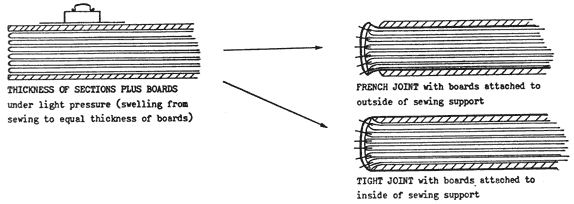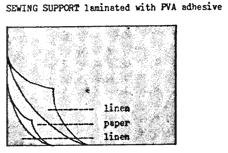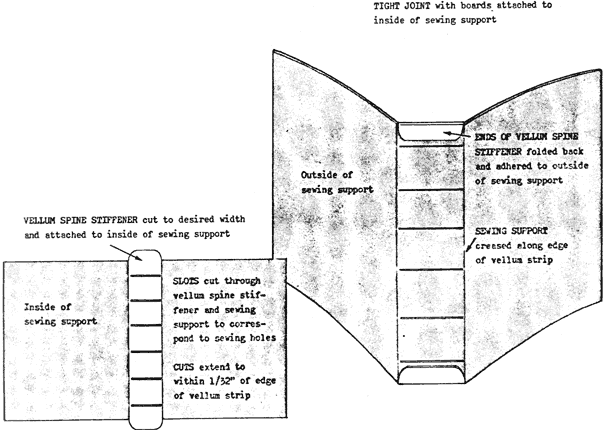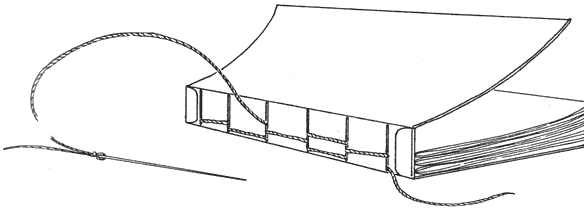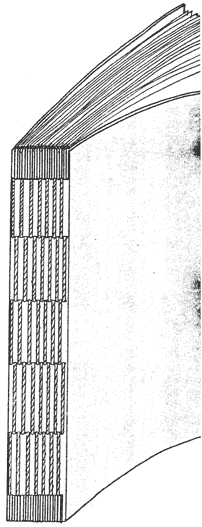An Experimental Book Structure for Conservation
by Linda K. Ogden and Margaret BrownWhen we as book conservators set out to design a book structure suitable for a specific conservation problem, we have the same methods of joining book leaves to choose from today as earlier binders had—either some form of sewing or some type of adhesive, or a combination of the two. Our choice is governed, as is any other bookbinder's, by the text material, its size, flexibility and weight, its condition and intended use, the materials available to us, and the cost. As conservators, however, we are also concerned that, if necessary, the structure could be undone without harm to the original. The most 'conservative' form of structure, therefore, may well be some form of sewing which completely eliminates the necessity of using adhesives in contact with the original material. Even if an adhesive is thought to be completely reversible and non-damaging, its removal would at the very least take time and at worst could harm the original.
These notes describe an experimental book structure for conservation which evolved from attempts to find a suitable method for resewing Middle Eastern books. A major requirement for this structure is that no adhesive should be used on the original spine folds. Furthermore, to produce a binding which will appear sympathetic to contemporary Middle Eastern bindings, the structure should have a flat spine with little or no swelling and no backing. The spine should be flexible on opening yet not go concave. Original sewing holes should be utilized if possible and the board attachment should be stronger than the thinly pared leather which commonly attaches the boards to the textblocks of Middle Eastern bindings.
The structure which developed has proven suitable for many types of bound materials. Its basic feature is a one-piece sewing support which wraps around the. textblock, extending from head to tail and from fore-edge to fore-edge. The sewing support is a laminate of two layers of 'airplane' linen with a middle layer of paper. A strip of vellum stiffens the spine of the sewing support. Sewing passes through horizontal slits cut through the vellum and the sewing support. Boards may be attached directly to the sewing support, providing a continuous attachment from head to tail along the joint. After sewing, the structure may be covered in a number of different styles, from a limp cover of vellum or paper to a stiff cover with a French or a tight joint. Covering styles are not described in these notes.
Western historical precedents for this type of sewing may be found in European ledger binding of the late Middle Ages, which often featured exposed and decorated sewing through the covering materials, with semi-flexible or inflexible spines. A similar structure is also described in a current German binding manual as a method for sewing pamphlets.
The following text and diagrams discuss and illustrate this basic structure so that others may experiment with it. The materials suggested are experimental as well but are those which have worked well so far. An asterisk in the text indicates that the step being described is illustrated by a diagram.
Vellum spine stiffener and sewing support. The width of the vellum spine stiffener is determined by judging the finished width of the spine, which depends upon the style of covering chosen.* The spine stiffener should be cut about one inch longer than the text pages, with the ends pared. The weight of the piece of vellum will depend upon the size and weight of the text block. It should be flexible when the book is opened, but not so thin that the weight of the text causes the spine to take a concave shape when the book is closed and stood upright.
The sewing support is made up with two layers of linen and a middle layer of paper, laminated with a PVA adhesive.* It should be trimmed to the head-to-tail length of the sections and left wide enough to wrap around the textblock, extending slightly on the fore-edges. The fore-edges of the sewing support can be trimmed after sewing. If squares are desired on the finished binding, the sides of the sewing support should be left long enough to accommodate them but the spine length kept shorter.
The vellum spine stiffener should then be adhered to the inside of the sewing support, and the ends which extend at head and tail folded to the outside and stuck down.* This fold of vellum at the head and tail provides support for the endband sewing, preventing it from pulling through the backs of the sections. If a rounded rather than flat spine is desired, dampening the vellum before adhering it to the sewing support will cause it to dry with a slight round. (Note: Adhering the vellum to the outside of the sewing support will create a concave spine.)
Horizontal slits should now be cut through the vellum spine stiffener and sewing support to correspond to the sewing holes.* The cuts should extend to within 1/32" of the edge of the vellum stiffener, so that the strip is not cut into separate panels. A chisel is useful for making these cuts. Before beginning the sewing, the sides of the sewing support should be folded to the inside and creased along the edge of the vellum strip.*
Sewing. The sections are sewn all along.* If the thread comes out the second to the last hole, it enters the end hole of the succeeding section. If it comes out of the last hole, it enters the second hole from the end of the succeeding section. This means that every other section is not caught up at the last hole, but if endbands are worked through each section, they then will be. Thread appears inside the section only between every other pair of holes, giving the appearance of 'two-on' sewing and the advantage that a relatively heavier weight of thread may be used with less swelling.
Endbands. Endbands can be sewn continuously with the main sewing, but a separate sewing insures that a break in the endband thread will not loosen the main sewing. In the illustration, the endband consists of a continuous wrap around the end panels of the spine stiffener and sewing support, going through the center of each section.* An additional wrap around the spine stiffener and sewing support between sections may be necessary to make a solid wrap if the sections are thick.
Note on covering. When covering, the covering material rather than the sewing support should be slit for the head and tail turn-ins as if covering a book with laced-in endbands, thus retaining the full strength of the linen in the joint.
Linda K. McWilliamsDrawings by Margaret Brown
Office of the Assistant Director for Preservation
Administrative Department
Library of Congress
Figures
Notes
"An Experimental Book Structure for Conservation" was prepared by Linda (McWilliams) Ogden and Margaret Brown as a handout to accompany a display of non-adhesive binding structures presented by Linda Ogden at the Sixth Annual Meeting of the American Institute for Conservation, in Fort Worth, Texas, 1-4 June 1978. At that time both the author and the illustrator were conservators at the Library of Congress. Linda Ogden is currently a book conservator in private practice in Berkeley, California, and Margaret Brown continues to work in the Conservation Division at the Library of Congress.
Linda K. OgdenConservation of Rare Books
Margaret Brown
Conservation Division, Preservation Directorate
Library of Congress
Publication History
Received: Fall 1998
Paper delivered at the AIC 6th Annual Meeting, June 1-4, 1978, Fort Worth, Texas.
Papers for the AIC General Session are selected by committee, based on abstracts and there has been no further peer review. Papers are received by the compiler in the Fall following the meeting and the author is welcome to make revisions, minor or major.
Note from the Editor
This text is being published at the suggestion of Olivia Primanis, who consulted it in preparation for her presentation at the 1998 AIC meeting. The text is being published in its original format, unedited, and is an example of the type of archival material we think is useful to publish in the Annual—material never officially published but referred to periodically, existing in scattered photocopies, and of permanent value to our profession.

